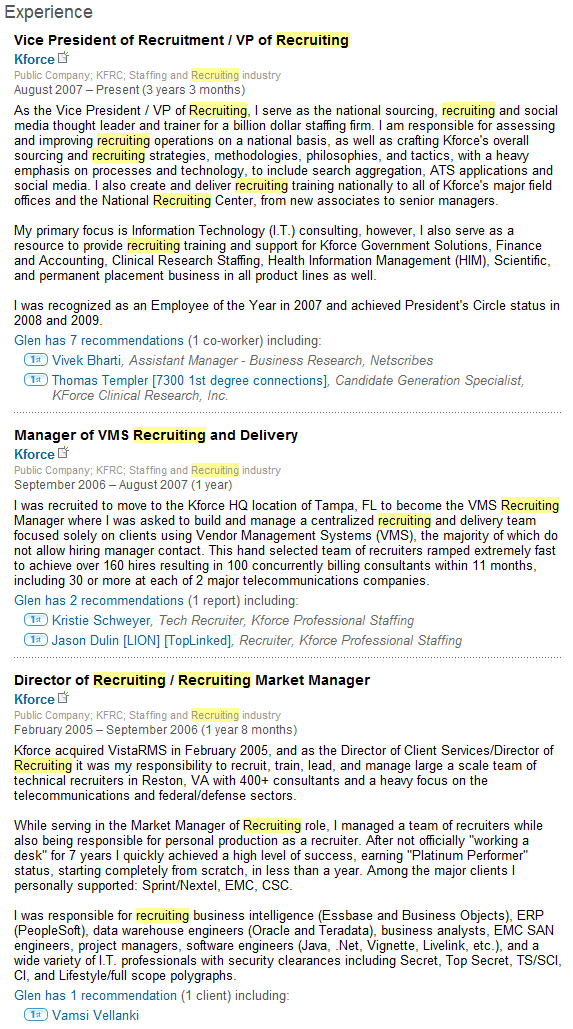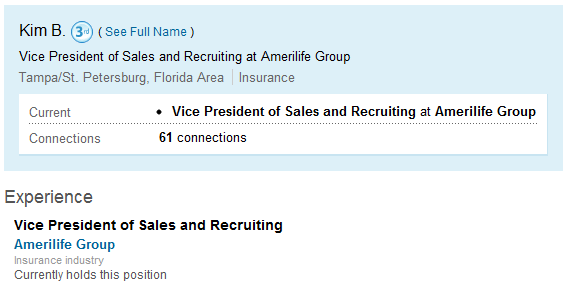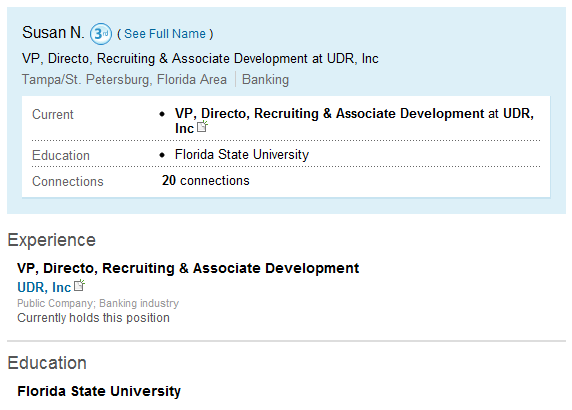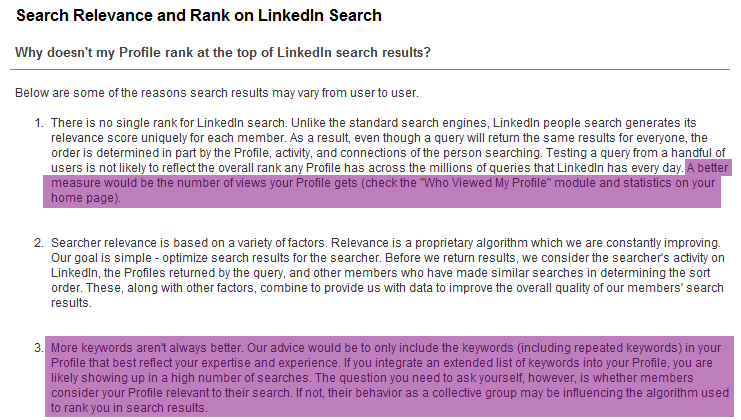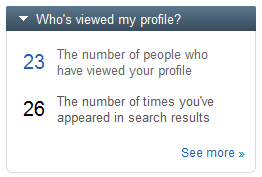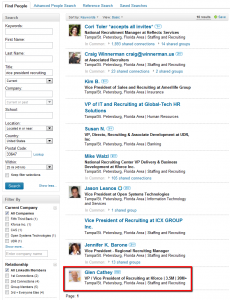 I recently wrote about what happens when you search for yourself on LinkedIn.
I recently wrote about what happens when you search for yourself on LinkedIn.
Now I’d like to address what happens when people don’t search for you by name, but rather try to find people like you using “regular” keywords and titles.
When it comes to Internet search, the goal for most people and companies is to be on the first page of search results for your keywords, and ideally #1 if at all possible.
When you search LinkedIn with the titles you have on your profile and keywords you’ve mentioned in your metro area, do you show up in the first 10 results?
Have you ever wondered if there was anything you could do to positively affect your ranking in search results when someone searches LinkedIn looking for people like you? Have you seen heavily keyword-loaded LinkedIn profiles and wondered if it really does any good?
You could get lost in all of the YouTube videos and blog posts on the subject of LinkedIn profile optimization, but most of it is pure speculation.
Before I go into some detail as to what I think is going on with LinkedIn search ranking and what you might be able to do to positively affect your ranking, I’d like to show you a little experiment I’ve run and ask you to do something similar and see what happens.
You have searched or have had someone else search LinkedIn by the titles and keywords you used on your profile to see where you rank, haven’t you?
Analyze Your LinkedIn Search Ranking for Title and Keywords
I searched in a 25 mile radius of my zip code with these three words in the title field, selecting current: vice president recruiting, and I sorted by keywords. If you’re logged in, this link should take you to the search. I am not sure about what you get, but I get 10 results, and I am dead last. :-)
Here is a brief analysis of the keyword count of the top 5 results that I see in comparison to my LinkedIn profile:
Result #1
- VP – 4 mentions (LinkedIn seems to give positive hits on “VP” when you search for “Vice”)
- Vice – 0 mentions
- Recruiting – 9 mentions
Result #2
- VP – 2 mentions
- Vice – 0 mentions
- Recruiting – 12 mentions
Result #3
- VP – 0 mentions
- Vice – 3 mentions
- Recruiting – 3 mentions
Result #4 (Had 0 connections, by the way)
- VP – 2 mentions
- Vice – 0 mentions
- Recruiting 2 mentions
Result #5
- VP – 3 mentions
- Vice – 0 mentions
- Recruiting – 3 mentions
Result #10 – last result = me
- VP – 5 mentions
- Vice – 6 mentions
- Recruiting – 40+
Yes, I sorted by keywords. Does the order of these results make any sense to you? They certainly don’t based on any standard keyword relevance ranking.
As a frame of reference, here’s my experience section, showing you I didn’t even go out of my way to load up on the word “recruiting” in my profile – they’re legitimate mentions, not keyword spam.
And yet, I am somehow last, behind results like these, ranked #3 and #5 respectively:
Really?
Yes – those are the full profiles.
Does LinkedIn Favor Less Activity and Fewer Connections?
In a word, no.
I’ve had a few people respond to my previous post suggesting that perhaps LinkedIn’s algorithm favors profiles with less connections and activity. For example, Jodi Raines commented that, “If the purpose of the algorithm is to increase the depth of the Linked in experience, it would be weighted to promote those with less activity and smaller networks first. It does seem counter intuitive, but from a marketing perspective it makes sense. The heavy user is already savvy and will find the person he’s seeking,… the lower frequency user may need a boost to help them get more entrenched. This is still ‘freemium” for the most part, and encouraging more participation by the new or less frequent users does make sense.”
I must say that although the idea that LinkedIn might be weighing and ranking search results to promote those with less activity and smaller networks first (and thus “penalizing” more active users and those with larger networks) can seem to make sense.
However, favoring profiles of people with smaller networks and less activity does not achieve the goal of searching LinkedIn (or any site or network), which is to find the most relevant people/results. If the most relevant result for any given person searching LinkedIn happens to be someone with a large network and a great deal of activity, does it make sense to not have that profile ranked as the #1 result, ahead of those that are less relevant to the searcher, but just happen to be less active and have smaller LinkedIn networks?
Not only does it not make sense, from my extensive LinkedIn searching experiments, I don’t see any consistent pattern of favoring less active profiles with people with smaller networks. Do you?
LinkedIn Favors “Relevant” Profiles in Search Ranking
Sounds obvious, right?
Not so fast.
The word “relevance,” according to the Merriam Webster dictionary, is “the ability (as of an information retrieval system) to retrieve material that satisfies the needs of the user.”
No one but you (the user) can ultimately determine relevance, because systems, search engines and LinkedIn cannot and do not know what satisfies your information needs.
Based on something I found in LinkedIn’s FAQs, it appears that LinkedIn favors results that other people have found to be “relevant.” Read the entire answer carefully, paying close attention to the highlighted sections:
Interesting, yes?
So how can LinkedIn determine which profiles may be more relevant to you?
After some late night conversations with Eric Jaquith on the matter and reading the above answer from LinkedIn over and over, I think I’ve figured this out, at least for the most part.
If your LinkedIn profile is keyword-loaded and you are pulled up in many searches, that’s only good if the people who are pulling you up in their search results actually click on and view your profile.
If your LinkedIn profile comes up in a lot of searches, but most people don’t look at your profile from the results page and decide to click and view your entire profile, LinkedIn’s algorithm makes a note that you were not as relevant as the search results that actually were opened and viewed.
This can happen to people who try to cover too much ground in their LinkedIn profile and use terms that can be ambiguous and non-specific in describing their skills and experience – words which can be returned by people looking for the words you mention, but not people like you. That makes your profile what is known as a “false positive” result – the words match, but you’re not a match for what the searcher is looking for.
LinkedIn Profile Search Optimization
If you want to ensure that you rank highly in the search results of people who are looking for people with your skills and experience in your metro area, you need to be very thoughtful with regard to what terms you use in your LinkedIn profile, and keyword-loading doesn’t work like most people assume it would.
Your best bet is to try and use words that are highly specific to your skills, experience and expertise, and ideally – words that are not very ambiguous.
Ambiguous terms can have different meanings to different people. Try to avoid terms that people who do something other than what you’ve been primarily responsible for in your career could use as well.
For example, when I recently reviewed my own LinkedIn profile, I decided to remove all of the specific technologies I have ever recruited for. For quite some time, sections of my LinkedIn profile made mention of several software development languages, databases and business intelligence solutions (and much more) where I described the types of professionals I have been responsible for recruiting.
Having terms like Java, Oracle and Cognos on my LinkedIn profile meant that people searching for Java, Oracle and/or Cognos professionals could return my profile in their search results. However, the mentions of their search terms in my profile would be “false positive” hits, and I would not be a relevant match for their search – and they could easily see this from my headline in the search results and thus most would never click on and open my profile.
This would send a signal to LinkedIn’s algorithm that I am not a relevant result – not just to that one person, but in general. That’s my interpretation of what information LinkedIn has shared online – if anyone from LinkedIn would like to confirm or deny this… :-)
The more ambiguous a term, the more likely it becomes that people will pull your profile up in their searches, but you won’t be what they are looking for – which means they are not likely to click on and view your profile. Each time that happens, LinkedIn’s algorithm thinks you are less relevant.
This makes it especially challenging to “crack the code” of LinkedIn’s search optimization, because it is going to be different for each person. Ultimately, when you create your LinkedIn profile, you have to think like someone who is looking for someone like you, with your specific skills, experience and expertise, and the words that they would use to conduct a search.
Then, you have to make sure that what they can see in the listing of the search results, which includes at least your headline (basic view) and could also include your current and previous titles along with a few words (expanded or custom view), will entice them (i.e., appear relevant enough) to click on and view your profile, thus sending a note to LinkedIn’s algorithm that you are more relevant than profiles that were not clicked on and opened.
I’m Still a Little Confused, Are You?
So, even if I accept my own interpretation of LinkedIn’s search ranking explanation, I am still confused – specifically by my dead-last showing in search results for the words in my current title in my metro area.
I can’t imagine that many of the other 9 profiles that were returned (especially the ones with next to no information and typos in their headline!) were found and clicked on by more people than clicked on my profile.
Perhaps my low ranking had something to do with the various technologies I had previously listed in my profile which could have realistically driven down my relevance ranking to LinkedIn’s algorithm whenever I showed up in search results as a false positive.
I hope so, because I have since made some changes to my LinkedIn profile and I will be seeing if my ranking changes over time. If it does – I’ll let you know.
Perform Your Own LinkedIn Search Ranking Analysis
If you haven’t done so already, I strongly suggest that you perform some LinkedIn search ranking analyses, specifically searching LinkedIn for local profiles using words you mention in your title fields and experience descriptions to see where you rank. Let me know if you find anything interesting (or alarming, like I did!) and please do share any insights you have.
Thanks!
